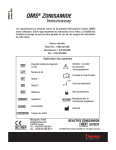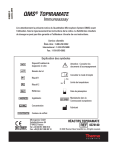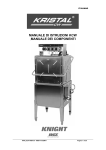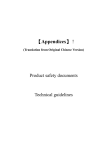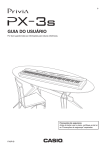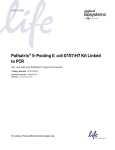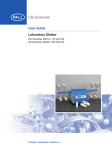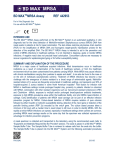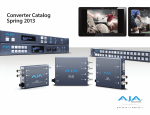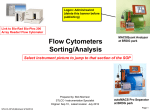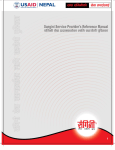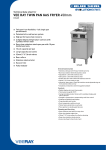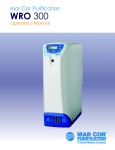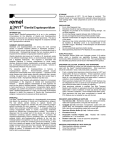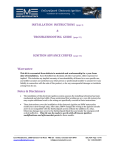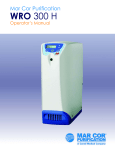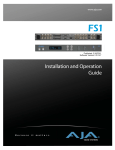Download 159.50_ver05 BeadRetriever User Manual
Transcript
BeadRetriever BeadRetriever User Manual User Manual Rev. 05; November 12, Product No. 159.50 Table of Contents BeadRetriever User Manual Rev. 05; November 12, Product No. 159.50 CONTENTS 1 SAFETY SYMBOLS AND MARKINGS........................................................................................... 6 2 ABOUT THE USER MANUAL ........................................................................................................ 7 3 INTRODUCTION TO THE BEADRETRIEVER ............................................................................... 8 4 FUNCTIONAL DESCRIPTION ........................................................................................................ 9 5 INSTALLATION............................................................................................................................. 14 6 ROUTINE OPERATION................................................................................................................. 18 7 MAINTENANCE............................................................................................................................. 22 8 TECHNICAL SPECIFICATIONS ................................................................................................... 25 9 TROUBLESHOOTING GUIDE ...................................................................................................... 27 10 WARRANTY CERTIFICATE ......................................................................................................... 32 11 ORDERING INFORMATION ......................................................................................................... 33 12 GLOSSARY AND ABBREVIATIONS ........................................................................................... 34 13 INDEX............................................................................................................................................. 36 14 TABLE OF FIGURES .................................................................................................................... 39 15 APPENDIX A. APPLICATION PROTOCOLS FOR BEADRETRIEVER USING DYNABEADS® FOR SELECTIVE CONCENTRATION OF TARGET MICROORGANISMS ................................. 40 16 APPENDIX B. BRIEF USER’S GUIDE.......................................................................................... 54 17 APPENDIX C. BEADRETRIEVER FEEDBACK FORM ................................................................ 55 18 APPENDIX D. ADDRESSES.......................................................................................................... 56 BeadRetriever User Manual; Rev. 05; November 12 2 Table of Contents TABLE OF CONTENTS 1 SAFETY SYMBOLS AND MARKINGS........................................................................................... 6 2 ABOUT THE USER MANUAL ........................................................................................................ 7 3 INTRODUCTION TO THE BEADRETRIEVER ............................................................................... 8 3.1 3.2 3.3 4 INTENDED USE ............................................................................................................................ 8 PRINCIPLE OF OPERATION ............................................................................................................ 8 ADVANTAGES OF PROCESSING MAGNETIC BEADS WITH BEADRETRIEVER ........................................ 8 FUNCTIONAL DESCRIPTION ........................................................................................................ 9 4.1 INSTRUMENT LAYOUT ................................................................................................................... 9 4.1.1 Front view .......................................................................................................................... 9 4.1.2 Back view......................................................................................................................... 10 4.1.3 Internal view..................................................................................................................... 10 4.2 BEADRETRIEVER MAGNETIC BEAD PROCESSOR ........................................................................... 11 4.3 PRINCIPLE OF MAGNETIC BEAD PROCESSING ............................................................................... 12 4.4 WORKING WITH A MAGNETIC ROD ............................................................................................... 12 4.4.1 Collecting magnetic beads .............................................................................................. 12 4.4.2 Releasing magnetic beads .............................................................................................. 12 4.4.3 Washing magnetic beads ................................................................................................ 13 4.4.4 Incubation ........................................................................................................................ 13 4.4.5 Changing the volume during the magnetic bead processing .......................................... 13 5 INSTALLATION............................................................................................................................. 14 5.1 WHAT TO DO UPON DELIVERY ..................................................................................................... 14 5.1.1 How to unpack ................................................................................................................. 14 5.1.2 Checking delivery for completeness................................................................................ 14 5.1.3 Checking for damage during transport ............................................................................ 14 5.1.4 Environmental requirements............................................................................................ 15 5.1.5 Things to avoid ................................................................................................................ 15 5.1.6 Technical prerequisites.................................................................................................... 15 5.2 SETUPS BEFORE YOU PUT THE INSTRUMENT INTO OPERATION ...................................................... 15 5.2.1 How to release the transport locks .................................................................................. 15 5.2.2 How to ensure startup ..................................................................................................... 17 5.3 OPERATIONAL CHECK ................................................................................................................ 17 6 ROUTINE OPERATION................................................................................................................. 18 6.1 6.2 6.3 6.4 7 SWITCHING ON .......................................................................................................................... 18 HOW TO USE THE KEYPAD AND DISPLAY ...................................................................................... 18 HOW TO START ....................................................................................................................... 19 SHUTDOWN ............................................................................................................................... 21 MAINTENANCE............................................................................................................................. 22 7.1 REGULAR AND PREVENTIVE MAINTENANCE .................................................................................. 22 7.1.1 How to clean the tube-strip tray....................................................................................... 22 7.1.2 How to clean the magnetic rods ...................................................................................... 22 7.1.3 How to clean the processing chamber ............................................................................ 22 7.2 DISPOSAL OF MATERIALS ........................................................................................................... 23 7.3 DECONTAMINATION PROCEDURE ................................................................................................ 23 7.4 HOW TO PACK FOR SERVICE ....................................................................................................... 24 7.5 SERVICE CONTRACTS ................................................................................................................ 24 7.6 DISPOSAL OF THE INSTRUMENT .................................................................................................. 24 8 TECHNICAL SPECIFICATIONS ................................................................................................... 25 8.1 8.2 GENERAL SPECIFICATIONS ......................................................................................................... 25 SAFETY SPECIFICATIONS............................................................................................................ 26 BeadRetriever User Manual; Rev. 05; November 12 3 Table of Contents 8.3 9 IN CONFORMITY WITH THE REQUIREMENTS .................................................................................. 26 TROUBLESHOOTING GUIDE ...................................................................................................... 27 9.1 ERROR MESSAGES AND WARNINGS............................................................................................. 27 9.2 TROUBLESHOOTING GUIDE ......................................................................................................... 28 9.3 FREQUENTLY ASKED QUESTIONS (FAQ) ABOUT BEADRETRIEVER PROCESSING ............................ 29 9.4 SERVICE REQUEST PROTOCOL ................................................................................................... 30 9.4.1 Decontamination.............................................................................................................. 30 9.4.1.1 10 10.1 10.2 11 Certificate of Decontamination ................................................................................................... 31 WARRANTY CERTIFICATE...................................................................................................... 32 WARRANTY CERTIFICATE ....................................................................................................... 32 WARRANTY LIMITATIONS ........................................................................................................ 32 ORDERING INFORMATION...................................................................................................... 33 11.1 LIST OF ACCESSORIES............................................................................................................ 33 11.2 LIST OF SPARE PARTS ................................................................................................................. 33 11.3 LIST OF RECOMMENDED SPARE PARTS ......................................................................................... 33 12 GLOSSARY AND ABBREVIATIONS ........................................................................................... 34 12.1 12.2 KEYWORDS FOR WEB PAGES .................................................................................................. 35 LITERATURE .......................................................................................................................... 35 13 INDEX............................................................................................................................................. 36 14 TABLE OF FIGURES .................................................................................................................... 39 15 APPENDIX A. APPLICATION PROTOCOLS FOR BEADRETRIEVER USING DYNABEADS® FOR SELECTIVE CONCENTRATION OF TARGET MICROORGANISMS ....................................... 40 AUTOMATED IMS USING DYNABEADS ANTI-E. COLI O157 ...................................................................... 41 AUTOMATED IMS USING DYNABEADS EPEC/VTEC PRODUCT SERIES (O145, O111, O103 AND O26).. 43 AUTOMATED IMS USING DYNABEADS ANTI-SALMONELLA ....................................................................... 46 AUTOMATED IMS USING DYNABEADS ANTI-LISTERIA .............................................................................. 48 AUTOMATED IMS USING DYNABEADS ANTI-LEGIONELLA ........................................................................ 50 AUTOMATED IMS USING DYNABEADS ANTI-GIARDIA AND ANTI-CRYPTOSPORIDIUM.................................. 52 16 APPENDIX B. BRIEF USER’S GUIDE...................................................................................... 54 17 APPENDIX C. BEADRETRIEVER FEEDBACK FORM............................................................ 55 18 APPENDIX D. ADDRESSES ..................................................................................................... 56 BeadRetriever User Manual; Rev. 05; November 12 4 Table of Contents Copyright Copyright 2012 Invitrogen Corporation. First edition published in 2000. All rights reserved. Reproduction of the accompanying user documentation in whole or in part is prohibited. Patents The BeadRetriever has national and international patents as well as patents pending. The production of Dynabeads is covered by various patents. Trademarks ( and ) Dynal, Dynabeads and SL are registered trademarks and BeadRetriever a trademark of Invitrogen Corporation, Carlsbad, California (USA). CHROMagar is a registered trademark of Dr. A. Rambach, Paris, France. Decon is a registered trademark of Decon Laboratories Limited. Envirochek is a registered trademark of Pall Corporation. Filta-Max is a registered trademark of IDEXX Laboratories, Inc. Microside SQ is a registered trademark of Global Biotechnologies, Inc. Tween is a registered trademark of ICI Americas, Inc., USA. Virkon is a registered trademark of Antec International Ltd. All other trademarks and registered trademarks are the sole property of their respective holders. Disclaimer Invitrogen reserves the right to change its products and services at any time to incorporate technological developments. This manual is subject to change without prior notice. Although this manual has been prepared with every precaution to ensure accuracy, Invitrogen assumes no liability for any errors or omissions, nor for any damages resulting from the application or use of this information. No liability for consequential damages Invitrogen shall not be liable for any indirect or consequential damages whatsoever arising out of the use or inability to use this product. BeadRetriever User Manual; Rev. 05; November 12 5 Chapter 1: Safety Symbols and Markings 1 SAFETY SYMBOLS AND MARKINGS These symbols are intended to draw your attention to particularly important information and alert you to the presence of hazards as indicated. SAFETY SYMBOLS USED IN THE BEADRETRIEVER Power ON Power OFF Serial number Catalog number Date of manufacture Consult Instructions for Use WEEE symbol This product is required to comply with the European Union’s Waste Electrical & Electronic Equipment (WEEE) Directive 2012/19/EC. WARNING MARKINGS USED IN THE DOCUMENTATION Caution: risk of electric shock. Caution: biohazard risk. Caution: risk of personal injury to the operator or a safety hazard to the surrounding area. Caution: risk of damage to the instrument, other equipment or loss of performance or function in a specific application. BeadRetriever User Manual; Rev. 05; November 12 6 Chapter 2: About the User Manual 2 ABOUT THE USER MANUAL This User Manual has been written for the actual user (e.g., laboratory technician) and provides information on the BeadRetriever magnetic bead processor, including the installation and operating instructions. Read the manual in its entirety prior to operating the instrument. This User Manual has been designed to give you the information you need to: • • • Install the BeadRetriever Use the BeadRetriever in routine jobs – the processing step Perform basic maintenance procedures. This User Manual also describes all the features and specifications of the BeadRetriever hardware and on-board software. APPENDIX A. Application Protocols for BeadRetriever using Dynabeads® for selective concentration of target microorganisms explains the processing principles and procedures. In Chapter 9 TROUBLESHOOTING GUIDE you will find explanations of all error messages and a problem-solving guide. The user should be familiar with the contents of Chapter 7 on maintenance. For warranty and ordering information, refer to Chapter 10 WARRANTY and Chapter 11 ORDERING INFORMATION. A CD-ROM video demonstrating use of the BeadRetriever and automated IMS (AIMS) is available to all users. Please request a CD by email: [email protected] or visit www.invitrogen.com/microbiology. BeadRetriever User Manual; Rev. 05; November 12 7 Chapter 3: Introduction to the BeadRetriever 3 INTRODUCTION TO THE BEADRETRIEVER 3.1 Intended use The BeadRetriever magnetic bead processor (Fig. 3.1) is intended for professional research and laboratory use by trained personnel. The instrument is intended for automated transfer and processing of magnetic beads in a 1 ml tube scale. Use for self-testing is excluded. 3.2 Principle of operation The principle of the BeadRetriever system (patents pending) is based on the use of magnetic rods covered with disposable, specially designed tip combs and tube strips. The instrument functions without any dispensing or aspiration parts or devices. Samples and reagents including magnetic beads are dispensed into the tube strips according to the corresponding kit instructions. The steps of the protocol that are selected by the user via the keypad and display have already been preloaded in the on-board software. Fig. 3.1 BeadRetriever magnetic bead processor 3.3 Advantages of processing magnetic beads with BeadRetriever The BeadRetriever magnetic bead processor provides several advantages relating mainly to the principle of operation in that it: • • • • • • • Enables automation of complicated manual steps Enables simultaneous processing and purification Enables a quicker reaction and a more efficient wash due to the simultaneous shaking during incubation and washing Facilitates a good collection of bead-bound sample due to the efficiency of the magnet By moving the beads from tube to tube during processing, contaminating background flora is reduced further Prevents carryover due to the fact that the same tip is only used for one sample Facilitates the whole processing with the aid of an internal program. BeadRetriever User Manual; Rev. 05; November 12 8 Chapter 4: Functional Description 4 FUNCTIONAL DESCRIPTION 4.1 Instrument layout 4.1.1 Front view 2 4 1 3 1 2 3 4 Keypad Display Front lid Top lid Fig. 4.1 BeadRetriever front view with lids closed Top lid Front lid Fig. 4.2 BeadRetriever front view with lids open BeadRetriever User Manual; Rev. 05; November 12 9 Chapter 4: Functional Description 4.1.2 Back view 3 1 2 4 1 2 3 4 ON/OFF switch Main power supply socket USB Serial port RS-232C Fig. 4.3 BeadRetriever rear view 4.1.3 Internal view 4 2 3 1 1 2 3 4 Tube-strip tray with tube strips Tip comb holder Tip comb slot with tip comb Magnetic rod Fig. 4.4 BeadRetriever internal view BeadRetriever User Manual; Rev. 05; November 12 10 Chapter 4: Functional Description 4.2 BeadRetriever magnetic bead processor The BeadRetriever instrument (Fig. 4.5) is designed for maximum 15 tube strips, which are compatible with the tip comb. The tube strip(s) is (are) kept stationary and the only moving assembly is the processing head with tip combs and magnetic rods. The head consists of two vertically moving platforms. One is needed for the magnetic rods (3 x 5 pieces) and the other one for the plastic tip combs (Fig. 4.4). One tube-strip tray contains fifteen separate tube strips and one sample uses one tube strip which is made up of five tubes. One tip comb containing five tips is used for processing five samples at a time. Before starting the magnetic bead processing via the keypad and display, the samples and reagents are dispensed into the tubes within the tube strips and the tip comb(s) is (are) loaded into its (their) slot(s). The tube strip(s) is (are) placed into the removable tray in the correct position and the tray is pushed into the end position. During the operation, the front and top lids can be closed (Fig. 4.1) or open (Fig. 4.2). Closed lids protect the processing against environmental contamination. The operating principle employed is inverse magnetic bead processing technology (Fig. 4.6). Rather than moving the liquids, the magnetic beads are moved from tube to tube containing specific reagents, in contrast to the external magnet method. Magnetic beads are transferred with the aid of magnetic rods covered with disposable, specially designed plastic tip combs. Fig. 4.5 BeadRetriever magnetic bead processor BeadRetriever User Manual; Rev. 05; November 12 11 Chapter 4: Functional Description 4.3 Principle of magnetic bead processing Magnetic rod Tip Transfer Transfer Magnetic bead suspension before collection Collection of magnetic beads Magnetic beads on the tip surface Release of Ready magnetic beads suspension Fig. 4.6 Inverse magnetic bead processing 4.4 Working with a magnetic rod Working with magnetic beads can be divided into five separate processes: • • • • • collecting beads releasing beads washing beads incubation concentration 4.4.1 Collecting magnetic beads During the collection of the magnetic beads, the magnetic rod is fully inside the tip. The magnetic rods together with the tip comb(s) move slowly up and down in the tubes within the tube strip and the magnetic beads are collected onto the wall of the tips. The magnetic rod together with the tip comb, having collected the magnetic beads, will lift out of the tube and be transferred into the next tube within the same tube strip. 4.4.2 Releasing magnetic beads After collection of the magnetic beads, the magnetic rods together with the tip comb(s) are lifted from the tubes, the magnetic rods are lifted up and the tip comb(s) is (are) lowered into the next tube in the tube strip containing a reagent. BeadRetriever User Manual; Rev. 05; November 12 12 Chapter 4: Functional Description Magnetic beads are released by moving the tip comb(s) up and down several times at considerably high speed until all the beads have been mixed with the substance in the next reaction. 4.4.3 Washing magnetic beads Washing the magnetic beads is a frequent and an important processing phase. Washing is a combination of the release and collection processes in a tube filled with washing solution. To maximize washing efficiency, the magnetic rods together with the tip comb(s) are designed to have minimized liquid-carrying properties. 4.4.4 Incubation To keep the magnetic bead suspension evenly mixed in long-running reactions, the tip comb(s) can be moved up and down from time to time. 4.4.5 Changing the volume during the magnetic bead processing The volume of the first tube can be larger than the volume of the next tube and this is used for concentration purposes (see Fig. 4.7 below). Fig. 4.7 A concentration step during magnetic bead processing BeadRetriever User Manual; Rev. 05; November 12 13 Chapter 5: Installation 5 INSTALLATION 5.1 What to do upon delivery 5.1.1 How to unpack Move the unpacked instrument to its site of operation. Unpack the BeadRetriever instrument and accessories carefully with the arrows on the transport package pointing upwards. The following notes and instructions are sent with the instrument and are immediately available when you open the package: • • • • the packing instructions/packing list the BeadRetriever Feedback Form the Warranty Certificate card the User Manual. Caution: DO NOT touch or loosen any screws or parts other than those specially designated in the instructions. Doing so might cause misalignment and will void the instrument warranty. To lift the instrument, put your fingers under the bottom on either sides and lift it with your back straight. Retain the original packaging for future transportation. The packaging is designed to assure safe transport and minimize transit damage. Use of alternative packaging materials may invalidate the warranty. Also retain all instrument-related documentation provided by the manufacturer for future use. 5.1.2 Checking delivery for completeness Check the enclosed packing list against order. If any parts are missing, contact Invitrogen or your local Invitrogen representative. 5.1.3 Checking for damage during transport Visually inspect the transport package, the instrument and the accessories for any possible transport damage. If the carton has been damaged in transit, it is particularly important that you retain it for inspection by the carrier in case there has also been damage to the instrument. Visually check all interconnections in the basic instrument. Check that there are no loose parts inside the instrument. If any parts are damaged, contact Invitrogen or your local Invitrogen representative. BeadRetriever User Manual; Rev. 05; November 12 14 Chapter 5: Installation 5.1.4 Environmental requirements When you set up your BeadRetriever, avoid sites of operation with excess dust, vibrations, strong magnetic fields, direct sunlight, draft, excessive moisture or large temperature fluctuations. • • • • • Make sure the working area is flat, dry, clean and vibration-proof and leave additional room for cables, lids, etc. Make sure that there is sufficiently room behind the instrument to enable disconnecting the device. Make sure the ambient air is clean and free of corrosive vapors, smoke and dust. Make sure the ambient temperature range is between +10°C (50°F) and +40°C (104°F). Make sure relative humidity is between 10% and 90% (non-condensing). Leave sufficient space (at least 10 cm) at both sides and at the back of the unit to allow adequate air circulation. The BeadRetriever does not produce operating noise at a level that would be harmful. No sound level measurements are required after installation. Warning: DO NOT operate the instrument in an environment where potentially damaging liquids or gases are present 5.1.5 Things to avoid DO NOT smoke, eat or drink while using the BeadRetriever. Wash your hands thoroughly after handling test fluids. Observe normal laboratory procedures for handling potentially dangerous samples. Use proper protective clothing. Use disposable gloves. Be sure the working area is well ventilated. Never spill fluids in or on the equipment. Warning: This product contains strong permanent magnets. People wearing a pacemaker or metallic prostheses should not use this product. A pacemaker or prostheses may be affected or damaged if it comes in very close contact with a strong magnetic field. 5.1.6 Technical prerequisites Place the instrument on a normal laboratory bench. The net weight of the unit is approx. 10 kg (23 lbs.). The instrument operates at voltages of 100–240 V a.c. The frequency range is 50/60 Hz. 5.2 Setups before you put the instrument into operation 5.2.1 How to release the transport locks Tools: 3 mm flat-head screwdriver (supplied with the instrument) Note: THERE ARE FOUR (4) TRANSPORT LOCKS (SCREWS) PRESENT (Fig. 5.2). A white tag with the red text ‘CAUTION! Remove Transport Lock Before Use’ is fastened to the instrument to BeadRetriever User Manual; Rev. 05; November 12 15 Chapter 5: Installation attract the user’s attention) (Fig. 5.1). The tag in Fig. 5.1 and the black arrows in Fig. 5.2 indicate where the transport locks are situated. Remove the tag and release the transport locks. Ensure that the transport locks have been released before you put the instrument into operation. Tag Fig. 5.1 BeadRetriever transport lock tag present before release of the locks 1. To remove the transport locks, unscrew the four (4) screws (Fig. 5.2) with the 3 mm flat-head screwdriver supplied. Make sure that the screws are fully unscrewed in the opposite direction. 2. Then remove the transport lock warning tag (Fig. 5.1). 3. Save the transport lock warning tag for future transportation. Tag attached here Fig. 5.2 Location of the transport lock screws and warning tag BeadRetriever User Manual; Rev. 05; November 12 16 Chapter 5: Installation 5.2.2 How to ensure startup 1. Warning: Ensure that the mains switch (Fig. 4.3) on the bottom left of the back panel is in the OFF position. 2. Connect the mains supply cable to the mains power socket (Fig. 5.3) at the bottom left of the back panel. If you need to use any other type of mains supply cable than supplied, use only cables certified by the local authorities. Before you plug in the power cable, ensure that the voltage on the rating label at the bottom left of the back panel (Fig. 4.3) corresponds to the local voltage. 3. Connect the instrument to a correctly installed line power outlet that has a protective conductor that is grounded. Warning: Never operate your instrument from a power outlet that has no ground connection. Fig. 5.3 Connecting the mains supply cable 5.3 Operational check 1. First switch the instrument ON. The instrument performs initialization tests and adjustments. The initialization tests are so-called self-tests. 2. The display quickly shows the internal software version and after that, the display shows one of the protocols in the internal memory. This happens when the initialization tests and adjustments have been completed. 3. It is recommended that you carry out an empty run (e.g., a demonstration) to verify proper instrument operation. BeadRetriever User Manual; Rev. 05; November 12 17 Chapter 6: Routine Operation 6 ROUTINE OPERATION 6.1 Switching on Before you switch on the BeadRetriever, ensure that the voltage on the rating label at the bottom left of the back panel (Fig. 4.3) corresponds to the local voltage. 6.2 How to use the keypad and display The liquid crystal display (LCD) is a 20 character by 2 line LCD. The lower line of the display can show the steps of the protocol, while the processing is running. The remaining time till the end of the process is shown in the top right corner. Furthermore, if errors occur, they will be displayed on the lower line. The keypad and display are shown in Fig. 6.1. Fig. 6.1 BeadRetriever keypad The keys available are: - - two cursor keys (or arrow keys, direction keys): to select the processing step to be run ▲ To change to the previous/next protocol by scrolling up. ▼ To change to the next protocol by scrolling down. two function keys START To initiate the processing step. STOP To pause/terminate the processing step. In short: STOP (paused)/START (the instrument continues after a pause step) STOP (paused)/STOP (the processing is terminated). BeadRetriever User Manual; Rev. 05; November 12 18 Chapter 6: Routine Operation 6.3 • How to START First of all slide the tube-strip tray out (Fig. 6.2). Fig. 6.2 Loading the tube-strip tray • A tube strip contains one sample and the reagents for a single processing. The user can select the position of the tube strip(s) on the tube-strip tray. The user must keep track of the sample order. However, the orientation of the tube strip is fixed. The tube strips have to be positioned so that the slip ends face left (Fig. 6.3 and Fig. 6.5). Note that the order in the tube strip of the sample and reagents is determined by the kit used. Load only maximum fifteen special tube strips at a time into the tray for processing (Fig. 6.5). Slide the tray fully back in. Magnetic rods Push the tip comb all the way in Tube-strip tray with tubes Fig. 6.3 Positioning of the tube-strip tray and insertion of the tip comb(s) • The tip comb(s) always has (have) to be in its (their) slot(s) and fully inserted (Fig. 6.3). The instrument also functions with either one tube strip or one to fifteen tube strips depending on the amount of samples. At least one tip comb (Fig. 6.4) always has to be inserted into one of the narrow slots meant for the tip comb. BeadRetriever User Manual; Rev. 05; November 12 19 Chapter 6: Routine Operation Fig. 6.4 Tip comb specially designed for the BeadRetriever • Close the front lid if you want to. The front lid protects the instrument against environmental contamination. Note: The front lid and/or top lid can be left open if desired. This action does not break the run. • Select the name of the method. • Use the START key to initiate the run. For startup refer to Section 6.1 Switching on. Note: At the end of the run, make sure that the text “End of run” is shown on the display, and then press the STOP key. Note: The samples are collected immediately after the run and transferred into other tubes for longer storage. Slip end faces left Fig. 6.5 Tube-strip tray containing tubes specially designed for the BeadRetriever BeadRetriever User Manual; Rev. 05; November 12 20 Chapter 6: Routine Operation 6.4 Shutdown Switch the BeadRetriever off by pressing the power switch (Fig. 4.3) at the bottom left of the back panel of the instrument into the OFF position. Remove any tube strips still on the tube-strip tray. Dispose of all tube strips as biohazardous waste. Remove any tip combs still in the instrument. Dispose of tip combs as biohazardous waste. Wipe the tray surface and the adjacent instrument surface with a soft cloth or tissue paper moistened with distilled water, a mild detergent (SDS, sodium dodecyl sulfate) or soap solution. If you have spilt infectious agents on the tray, disinfect with 70% alcohol or some other disinfectant (see Section 7.3 Decontamination procedure). BeadRetriever User Manual; Rev. 05; November 12 21 Chapter 7: Maintenance 7 MAINTENANCE 7.1 Regular and preventive maintenance For reliable daily operation keep the instrument free of dust and liquid spills. Abrasive cleaning agents are not recommended, because they are likely to damage the paint finish. It is recommended that you clean the case of the instrument periodically to maintain its good appearance. A soft cloth dampened in a warm, mild detergent solution will be sufficient. Clean the outside of the instrument and the tube-strip tray with clean low-pressure compressed air or a cloth dampened with water or a mild detergent when necessary. Although the BeadRetriever is constructed from high-quality materials, you must immediately wipe away spilt saline solutions, solvents, acids or alkaline solutions from outer surfaces to prevent damage. Painted surfaces can be cleaned with most laboratory detergents. Dilute the cleaning agent as recommended by the manufacturer. DO NOT expose painted surfaces to concentrated acids or alcohols for prolonged periods of time as damage may occur. Clean the display areas with a mild laboratory detergent. The keypad has a wipe-clean surface. Plastic covers and surfaces can be cleaned with a mild laboratory detergent or alcohol. If any surfaces have been contaminated with biohazardous material, a mild sterilizing solution should be used. DO NOT autoclave any part of this instrument except for the tube-strip tray. 7.1.1 How to clean the tube-strip tray Keep the tube-strip tray surface clean to avoid dust and dirt entering into the instrument. Clean the tray surface at least once a week using a soft cloth or tissue paper soaked in a mild detergent solution (SDS), soap solution or alcohol. If you have spilt infectious agents on the tube-strip tray, you can autoclave the tray. 7.1.2 How to clean the magnetic rods If required, wipe the magnetic rods using a soft cloth or tissue paper soaked in a mild detergent solution (SDS), soap solution or alcohol. 7.1.3 How to clean the processing chamber If required, clean the processing chamber using a soft cloth or tissue paper soaked in a mild detergent solution (SDS), soap solution or alcohol. BeadRetriever User Manual; Rev. 05; November 12 22 Chapter 7: Maintenance 7.2 Disposal of materials Refer to local regulations for the disposal of infectious material. The samples can be potentially infectious. Dispose of all used tube strips, tip combs, disposable gloves, syringes, disposable tips, etc. as biohazardous waste. 7.3 Decontamination procedure If there is any risk of contamination with biohazardous material, the procedure recommended below or some other corresponding decontamination procedure must be performed. It is strongly recommended that the complete decontamination procedure be performed before relocating the instrument from one laboratory to another. Decontamination is not required for the proper functioning of the instrument. Example of decontaminants • • • • • • Ethanol Virkon® solution Glutaraldehyde solution Chloramine T Microcide SQ® Decon® 90 70% 1―3% 4% 1:64 min. 4% Always use disposable gloves and protective clothing and operate in a wellventilated area. 1. Prepare the decontaminating agent: for example, 200 ml 4% glutaraldehyde solution (or another agent recommended by your safety officer). 2. Empty the tube-strip tray. 3. Switch OFF the power and disconnect the mains supply cable (Fig. 5.3). 4. Disinfect the outside of the instrument using a cloth dampened with 70% ethanol. 5. Place the instrument in a large plastic bag. Ensure that the lids are open. 6. Place a cloth soaked in the prepared solution into the bag. Ensure that the cloth does not make contact with the instrument. 7. Close the bag firmly and leave the instrument in the bag for at least 24 h. BeadRetriever User Manual; Rev. 05; November 12 23 Chapter 7: Maintenance 8. Remove the instrument from the bag. 9. Clean the instrument using a mild detergent. 10. Remove any stains using 70% ethanol. 11. After performing this decontamination procedure, label the instrument with a signed and dated Certificate of Decontamination. 7.4 How to pack for service When you ship the instruments for service remember to: • Inform about the use of hazardous materials. • Decontaminate the instrument beforehand. • Install the transport locks. • Pack the instrument according to the enclosed packing instructions. • Use the original packaging to ensure that no damage will occur to the instrument during shipping. Any damage will incur additional labor charges. • Enclose a dated and signed Certificate of Decontamination (see Section 9.4.1.1) both inside and attached to the outside of the package, in which you return your instrument (or other items). • Enclose the return authorization number (RGA) given by the Invitrogen representative. • Indicate the fault after you have been in touch with your local Invitrogen representative • See Section 8.1 for details on storage and transportation temperatures. 7.5 Service contracts It is recommended that you maintain and service the instrument regularly every twelve (12) months on a contract basis by the manufacturer’s trained service engineers. This will ensure that the product is properly maintained and gives trouble-free service. Contact your local Invitrogen representative for details. 7.6 Disposal of the instrument • Decontaminate the instrument prior to disposal. See Sections 7.3, 9.4.1 and 9.4.1.1 on decontamination. • Dispose of the instrument according to the legislation stipulated by the local authorities concerning take-back of electronic equipment and waste. The proposals for the procedures vary by country. • Regarding the original packaging and packing materials, use the recycling operators known to you. • For more information, contact your local Invitrogen office or local supplier. BeadRetriever User Manual; Rev. 05; November 12 24 Chapter 8: Technical Specifications 8 TECHNICAL SPECIFICATIONS 8.1 General specifications Technical specifications Overall dimensions Weight ca. 290 mm (W) x 290 mm (D) x 310 mm (H) [ 11.4 in. (W) x 11.4 in. (D) x 12.2 in. (H)] ca. 10 kg (23 lbs.) Operating conditions (Indoor use) Transportation conditions +10°C – +40°C, RH: 90% max. Storage conditions -25°C – +50°C, packed in transport packaging Mains power supply 100–240 V a.c., 50/60 Hz, nominal Automatic voltage detection Power consumption 40 VA max. Heat dissipation 136 BTU max. Computer interface Serial RS-232C port. USB. -40°C – +70°C, packed in transport packaging Performance specifications Tube-strip tray (autoclavable) Special design, 3 x 5 format Magnetic rods (fixed) 3 x 5 format Capacity 15 samples/run (3 x 5) Vessel volumes 50 μl – 1 ml Vessel type (disposable) Special tube strip, 1 x 5 tubes Tip comb (disposable) Special design, 1 x 5 format Magnetic bead size ca. > 1 μm Collecting efficiency 95%/vessel (washing buffer) Incubating temperature Ambient temperature (i.e., no incubation) Keyboard / Display START/STOP/two cursor keys/LCD Software Space for ca. 200 protocols (loading through the external PC) BeadRetriever User Manual; Rev. 05; November 12 25 Chapter 8: Technical Specifications 8.2 Safety specifications This section describes the safety specifications for the BeadRetriever instrument. 8.3 In conformity with the requirements BeadRetriever bears the following markings: Type 701 100–240 V a.c. 50/60 Hz, 40 VA CE mark BeadRetriever conforms to the following requirements: 2006/95/EC (Low Voltage Directive) 2004/108/EC (Electromagnetic Compatibility Directive, EMC) FCC Part 15, Subpart B/Class B (July 2004) 2012/19/EC (Waste of Electrical and Electronic Equipment) 2011/651/EC (RoHS Directive – Restriction of the Use of Certain Hazardous Substances in Electrical and Electronic Equipment) 2006/42/EC (Machinery Directive) The safety specifications are also met under the following environmental conditions in addition to or in excess of those stated in the operating conditions: Altitude: Temperature: Humidity: Mains supply fluctuations: Installation category (overvoltage category): Pollution degree: Up to 2000 m +5°C to +40°C Maximum relative humidity 80% for temperatures up to 31°C decreasing linearly to 50% relative humidity at 40°C ± 10% from nominal II according to IEC 60664-1 (see Note 1) 2 according to IEC 60664-1 (see Note 2) Notes 1. The installation category (overvoltage category) defines the level of transient overvoltage, which the instrument is designed to withstand safely. It depends on the nature of the electricity supply and its overvoltage protection means. For example, in CAT II, which is the category used for instruments in installations supplied from a supply comparable to public mains, such as hospital and research laboratories and most industrial laboratories, the expected transient overvoltage is 2500 V for a 230 V supply and 1500 V for a 120 V supply. 2. The pollution degree describes the amount of conductive pollution present in the operating environment. Pollution degree 2 assumes that normally only nonconductive pollution, such as dust, occurs with the exception of occasional conductivity caused by condensation. BeadRetriever User Manual; Rev. 05; November 12 26 Chapter 9: Troubleshooting Guide 9 TROUBLESHOOTING GUIDE 9.1 Error messages and warnings Error message Command error Cannot move track Head position error Head timeout Track position error Track timeout Magnets pos. error Magnets timeout Serial number error Serial no already set Too high pos. offset Invalid parameter Out of memory No acceleration tbl NV parameters lost Program full Warning Time already expired BeadRetriever User Manual; Rev. 05; November 12 27 Chapter 9: Troubleshooting Guide 9.2 Troubleshooting guide Error Cause Action • Cannot move track The track cannot be moved because the head is not up. Press STOP. If the fault cannot be remedied, then switch the power on and off. • Head position error The calculated head position does not agree with the head home sensor signal. Check that there is nothing preventing the head from moving up and down. • Head timeout The head has not arrived at the home sensor within the allowed time. Check that there is nothing preventing the head from moving up and down. • Track position error The calculated track position does not agree with the track home sensor signal. Check that there is nothing preventing the track from moving left or right. • Track timeout The track has not arrived at the home sensor within the allowed time. Check that there is nothing preventing the track from moving left or right. • Magnets position error The calculated magnetic rod position does not agree with the rod home sensor signal. Check that there is nothing preventing the magnetic rods from moving up and down. Ensure that the tip comb is fully in. • Magnets timeout The magnetic rods have not arrived at the home sensor within the allowed time. Check that there is nothing preventing the magnetic rods from moving up and down. • Nonvolatile parameters lost The nonvolatile parameters of the instrument are lost. Contact authorized service. BeadRetriever User Manual; Rev. 05; November 12 28 Chapter 9: Troubleshooting Guide 9.3 Frequently asked questions (FAQ) about BeadRetriever processing Q1: What does the BeadRetriever do? A1: Dynabeads-based products for microbiology have been designed for automated immunomagnetic separation (AIMS) of these target organisms from food, feed and environmental samples. The process can selectively concentrate the specific pathogenic microorganisms from sample materials. Invitrogen now offers a complete BeadRetriever system (the magnetic bead processor and the reagents) for the purification of microbial samples. The processor handles beads automatically according to the preloaded protocol. Q2: Do I need a PC to control the processor? A2: The protocols are preloaded by Invitrogen and no PC is needed for routine use. A PC program can be used to create new protocols or modify existing protocols if needed. PC-modified protocols are then downloaded into the processor for routine use. Q3: Will the magnets get weaker? If so, how long can they be used? Can they be replaced? A3: The BeadRetriever magnets are made of material that is very stable. The magnetic field will not get weaker. Magnets can be replaced if needed. Usually there is no need to replace them, but it can be done, e.g., if they are mechanically damaged during runs. Local technical personnel can carry out changing the magnets. Q4: How strong are the magnets? Can they disturb, e.g., some sensitive equipment? A4: The BeadRetriever should not be kept in close proximity to magnetic tapes, computer discs or other magnetic storage systems, such as credit cards, as these can be damaged by the strong magnetic field of the BeadRetriever heads. Do not hold the BeadRetriever heads close to a PC display, since this may cause damage to the display. Do not use metal tools when handling BeadRetriever heads. Q5: What happens if I forget to insert the tip combs into the tip comb holder and the magnetic beads stick to the magnetic rods? A5: Wipe the magnetic rods using a soft cloth or tissue paper soaked in a mild detergent solution, soap solution or alcohol. Q6: What if the magnetic beads remained in the well? A6: If the starting material is too viscose, the magnetic rods will not be able to collect the beads. Dilute the sample and check that the sample is properly homogenized/lysed. Q7: What if magnetic beads are attached to the tip combs? A7: This happens sometimes but it will not affect the yield because the sample has been released from the beads. Q8: Are the volumes of reagents in each well critical? A8: It is strongly recommended that you keep the given volumes within certain limits to avoid failure in performance of the chemical reactions and the processor. BeadRetriever User Manual; Rev. 05; November 12 29 Chapter 9: Troubleshooting Guide 9.4 Service request protocol If the BeadRetriever requires service, contact your local Invitrogen representative. DO NOT under any circumstances send the instrument for service without any prior contact. It is imperative to indicate the fault and nature of the required service. This will ensure a faster return of the instrument to the customer. The Invitrogen representative will prepare a complaint form (Complaint-order) containing a detailed description of the fault, symptom or condition based on the information you give them. Check Section 7.4 How to pack for service. You will find instructions on how to proceed before shipping the instrument for service. Check that any necessary decontamination procedure has been carried out before packing. See Sections 9.4.1 and 9.4.1.1 on decontamination. Refer also to Section 7.3 Decontamination procedure. Ensure that the Certificate of Decontamination as well as the return authorization number (RGA) are sent with the instrument. Your local Invitrogen representative will keep you up to date with the progress of service and provide you with any further details you might need, e.g., on maintenance, serviceability, troubleshooting and replacement. 9.4.1 Decontamination Decontamination should be performed in accordance with normal laboratory procedures. Any decontamination instructions provided with the reagents used should be followed. A decontamination procedure is only recommendable when infectious substances have been in direct contact with any part(s) of the instrument. BeadRetriever User Manual; Rev. 05; November 12 30 Chapter 9: Troubleshooting Guide 9.4.1.1 Certificate of Decontamination The decontamination procedure is required prior to shipping the instrument to Invitrogen, e.g., for repair. If the instrument is shipped back to Invitrogen it must be accompanied by a dated and signed Certificate of Decontamination, which must be attached to the outside of the package containing the instrument. See Section 7.3 Decontamination procedure. Failure to confirm decontamination will incur additional labor charges or at worst the items will be returned for proper cleaning. Before returning any instrument(s) or item(s), ensure that they are fully decontaminated. Confirm A or B status: Name: Address: Tel./Fax: Name: Serial no.: A) I confirm that the returned items have not been contaminated by body fluids, toxic, carcinogenic or radioactive materials or any other hazardous materials. B) I confirm that the returned items have been decontaminated and can be handled without exposing the personnel to health hazards. Materials used in the unit: Chemicals + Biological • Radioactive *) Specific information about contaminants: Decontamination procedure1: Date and place: Signature: Name (block capitals): * The signature of a Radiation Safety Officer is also required when the unit has been used with radioactive materials. This unit is certified by the undersigned to be free of radioactive contamination. Date and place: Signature: Name (block capitals): 1 Please include decontaminating solution used. BeadRetriever User Manual; Rev. 05; November 12 31 Chapter 10: Warranty Statement 10 WARRANTY CERTIFICATE 10.1 Warranty Certificate The BeadRetriever is fully guaranteed against defective parts and materials, including defects caused by poor workmanship, for a period of one year from the date of delivery. Invitrogen will repair or replace defective parts or materials during the term of warranty at no extra charge for materials and labor provided that the products were used and maintained in accordance with Invitrogen Instructions for Use. The warranty is invalid if products have been misused or abused. For the warranty to be effective, the product must have been purchased either directly from Invitrogen subsidiaries or distributors. The guarantee is not transferable to a third party without prior written approval from Invitrogen. This guarantee is subject to the following exclusions: • Any defects caused by normal wear and tear. • Defects caused by fire, lightning, flood, earthquake, explosion, sabotage, war, riot, or any other occurrence of the type listed above. • Refurbished products that are subject to different warranty conditions. THIS WARRANTY IS IN LIEU OF ALL OTHER EXPRESSED OR IMPLIED WARRANTIES, INCLUDING BUT NOT LIMITED TO ANY IMPLIED WARRANTIES OF MERCHANTABILITY OR FITNESS FOR A PARTICULAR PURPOSE. The seller is not liable for any loss or damage arising out of or in connection with the use of the product or other indirect damages. These warranty terms and conditions can be obtained from your local Invitrogen representative. This card acts as a warranty certificate. 10.2 Warranty limitations • • Consumables are not included in the warranty. The warranty does not extend beyond the expiration date of the reagent kit. BeadRetriever User Manual; Rev. 05; November 12 32 Chapter 11: Ordering Information 11 ORDERING INFORMATION Code Instrument / System 159.50 BeadRetriever™, 100–240 V 11.1 List of accessories Code Item Quantity 1508270 BeadRetriever™ User Manual 1 159.51 BeadRetriever™ Tubes and Tips 1 11.2 List of spare parts Code Item 159.52 Tube-strip tray = Tube Rack Quantity 1 11.3 List of recommended spare parts Code Item* 1091 910 1092 250 2004 460 2004 470 2004 480 2104 0811 2104 0820 2104 0850 2407 0740 2407 2550 Tooth belt T2.5/330 Tooth belt T2.5/265 PCB PSP-01 PCB CSU-02 PCB CSU-01 Power supply H-motor assembly M-motor assembly Free wheel assembly Magnetic plate assembly 1 – 2 unit(s) / year 1 1 1 10 units / year 1 1 1 2 1 2 1 1 3 1 * = Contact your local Invitrogen representative BeadRetriever User Manual; Rev. 05; November 12 33 Chapter 12: Glossary and Abbreviations 12 GLOSSARY AND ABBREVIATIONS AIMS Automated immunomagnetic separation. BGA Brilliant Green Agar. BPW Buffered Peptone Water. BRILA Brilliant Green Bile Lactose Broth. BSA Bismuth Sulfite Agar or Bovine Serum Albumin. CT Cefixime-Tellurite; e.g., CT supplement and CT-SMAC. EMB Eosin Methylene Blue. EPEC Enterotoxin producing Escherichia coli. GN Gram-negative; e.g., GN broth. HC Haemorrhagic Colitis Agar; e.g., mHC = modified Haemorrhagic Colitis Agar. HE Hektoen Enteric Agar. IMS Immunomagnetic separation. Magnetic rod The rods that are magnetic and collect magnetic beads. The rods do not collect the beads on their own; the magnetic rods must always be protected by a tip comb. PBST (PBS-Tween) Phosphate Buffered Saline containing 0.05% Tween® 20. RVS Rappaport Vassilliadis Soya peptone broth. SMAC Sorbitol MacConkey media. Tip comb Protects the magnetic rod. A disposable tip comb always has to be fitted into the tip comb holder slot during processing. TBST Tris buffered saline with Tween; e.g., TBST-BSA. TSB Tryptone Soya Broth; e.g., mTSB = modified Tryptone Soya Broth. Tube strip The disposable tubes where all the reagents and samples are located and where the processing takes place. Tube-strip tray (Tube rack) A removable tube-strip tray or tube rack that holds 15 tube strips (Fig. 6.3 and Fig. 6.5). VCC Vancomycin Cefsulodin Cefixime. VTEC Verocytotoxin producing Escherichia coli. XLD Xylose Lysine Desoxycholate medium. BeadRetriever User Manual; Rev. 05; November 12 34 Chapter 12: Glossary and Abbreviations 12.1 Keywords for web pages AIMS automated IMS BeadRetriever Cryptosporidium Dynabeads E. coli O157 EPEC/VTEC IMMUNOMAGNETIC SEPARATION Giardia IMS Listeria 12.2 magnetic beads magnetic separation processing processor purification Salmonella separation separator superparamagnetic beads Thermo Fisher Scientific Thermo Scientific Literature A collection of articles illustrating the use of Dynabeads-based IMS protocols for the isolation of bacteria and protozoa is available at our website. These articles include protocols for: • • • • • • • E. coli O157 from Meat E. coli O157 & other EPEC/VTECs Giardia Listeria Salmonella spp. Salmonella and Eggs Cryptosporidium Visit our website at www.invitrogen.com/microbiology. BeadRetriever User Manual; Rev. 05; November 12 35 Chapter 13: Index 13 INDEX A Abbreviations ........................................................................................................................................34 Accessories......................................................................................................................................14, 33 Advantages of processing magnetic particles.......................................................................................8 AIMS ..................................................................................................7, 29, 34, 35, 40, 41, 44, 46, 48, 50 Application...........................................................................................................................5, 6, 7, 40, 55 Application protocol..........................................................................................................................7, 40 Automated IMS using Dynabeads anti-E. coli O157........................................................................41 Automated IMS using Dynabeads anti-Legionella ..........................................................................50 Automated IMS using Dynabeads anti-Listeria................................................................................48 Automated IMS using Dynabeads anti-Salmonella ...................................................................46, 50 Automated IMS using Dynabeads EPEC/VTEC product series (O145, O11, O103 and O26) ........43 Automated immunomagnetic separation ..................................7, 29, 34, 35, 40, 41, 43, 44, 46, 48, 50 B BeadRetriever .....5, 7, 8, 9, 10, 11, 14, 15, 16, 18, 20, 21, 22, 29, 30, 32, 33, 35, 39, 40, 41, 43, 46, 47, 48, 50, 51, 54 C Check .....................................................................................................................................................28 Clean ....................................................................................................................................15, 22, 24, 29 magnetic rods ....................................................................................................................................22 processing chamber ..........................................................................................................................22 Concentration ......................................................................................................7, 12, 13, 39, 40, 43, 46 D Decontamination ...........................................................................................................21, 23, 24, 30, 31 Certificate of ...........................................................................................................................24, 30, 31 Dimensions ............................................................................................................................................25 Directives ...............................................................................................................................................26 Disinfection procedure..................................................................................................21, 23, 24, 30, 31 Disposal of materials.............................................................................................................................23 Dynabeads ...............................................................................5, 7, 29, 35, 40, 41, 43, 44, 46, 48, 49, 50 Dynal ............................................................................................................................................5, 42, 44 E Environmental requirements ................................................................................................................15 Error message ...................................................................................................................................7, 27 F FAQ ........................................................................................................................................................29 Feedback Form......................................................................................................................................14 Frequently asked questions..................................................................................................................29 H How to install the BeadRetriever ..........................................................................................................14 I Immunomagnetic separation................................................7, 29, 34, 35, 40, 41, 42, 43, 44, 46, 48, 50 IMS ...............................................................................................7, 34, 35, 40, 41, 42, 43, 44, 46, 48, 50 Incubation ........................................................................................................................8, 12, 13, 25, 46 BeadRetriever User Manual; Rev. 05; November 12 36 Chapter 13: Index Installation..............................................................................................................................7, 15, 24, 26 Instrument layout ....................................................................................................................................9 Intended use ............................................................................................................................................8 Inverse magnetic particle processing ............................................................................................11, 12 K Keypad and display...............................................................................................................8, 11, 18, 54 Keys..................................................................................................................................................18, 25 Keywords for web pages ......................................................................................................................35 Kit .....................................................................................................................................8, 19, 32, 45, 55 L Literature................................................................................................................................................35 M Magnetic particles .................................................................................................................................34 collection of........................................................................................................................................12 release of............................................................................................................................................12 wash of .........................................................................................................................................12, 13 Magnetic rod .....................................................................................8, 10, 11, 12, 13, 22, 25, 28, 29, 34 Mains..........................................................................................................................................23, 25, 26 Maintain ...........................................................................................................................................22, 24 Maintenance ..........................................................................................................................7, 22, 24, 30 O Operational check..................................................................................................................................17 Ordering information ........................................................................................................................7, 33 P Packing.......................................................................................................................................14, 24, 30 instructions...................................................................................................................................14, 24 list .......................................................................................................................................................14 materials.............................................................................................................................................24 PCR.........................................................................................................................................................45 Plate .............................................................................................................29, 33, 42, 44, 45, 48, 49, 51 Processing head ....................................................................................................................................11 Protocol......................................................................................................................8, 18, 29, 30, 50, 54 S Samples .............................................8, 11, 15, 19, 20, 23, 25, 29, 34, 40, 41, 43, 44, 46, 47, 48, 50, 54 Separation ...............................................................................................................29, 34, 35, 40, 43, 48 Service .................................................................................................................................24, 25, 28, 30 contracts.............................................................................................................................................24 pack for.........................................................................................................................................24, 30 request protocol ................................................................................................................................30 Shutdown ..............................................................................................................................................21 Specifications ..............................................................................................................................7, 25, 26 general................................................................................................................................................25 performance.......................................................................................................................................25 safety ..................................................................................................................................................26 Startup .............................................................................................................................................17, 20 Symbols ...................................................................................................................................................6 T Table of Figures.....................................................................................................................................39 Tip comb....................8, 10, 11, 12, 13, 19, 20, 21, 23, 25, 28, 29, 34, 39, 40, 41, 42, 44, 47, 48, 50, 54 Transport .........................................................................................................................................14, 25 damage...............................................................................................................................................14 BeadRetriever User Manual; Rev. 05; November 12 37 Chapter 13: Index lock ...................................................................................................................................15, 16, 24, 39 package ..............................................................................................................................................14 Troubleshooting ..............................................................................................................................28, 30 Tube rack .......................................................................................................................33, 34, 44, 48, 50 Tube strips .........................................8, 10, 11, 12, 19, 21, 23, 25, 34, 40, 41, 42, 44, 46, 47, 48, 50, 54 Tube-strip tray .........................................................10, 11, 19, 20, 21, 22, 23, 25, 33, 34, 39, 44, 48, 54 U Unpack ...................................................................................................................................................14 User manual...........................................................................................................................................33 V View ...................................................................................................................................................9, 10 front ................................................................................................................................................9, 39 internal..........................................................................................................................................10, 39 rear ...............................................................................................................................................10, 39 Voltage ...........................................................................................................................15, 17, 18, 25, 26 W Warnings........................................................................................................................15, 16, 17, 27, 39 Warranty ......................................................................................................................................7, 14, 32 Weight..............................................................................................................................................15, 25 BeadRetriever User Manual; Rev. 05; November 12 38 Chapter 14: Table of Figures 14 TABLE OF FIGURES FIG. 3.1 BEADRETRIEVER MAGNETIC BEAD PROCESSOR .............................................................................. 8 FIG. 4.1 BEADRETRIEVER FRONT VIEW WITH LIDS CLOSED ........................................................................... 9 FIG. 4.2 BEADRETRIEVER FRONT VIEW WITH LIDS OPEN ............................................................................... 9 FIG. 4.3 BEADRETRIEVER REAR VIEW ....................................................................................................... 10 FIG. 4.4 BEADRETRIEVER INTERNAL VIEW ................................................................................................. 10 FIG. 4.5 BEADRETRIEVER MAGNETIC BEAD PROCESSOR ............................................................................ 11 FIG. 4.6 INVERSE MAGNETIC BEAD PROCESSING ........................................................................................ 12 FIG. 4.7 A CONCENTRATION STEP DURING MAGNETIC BEAD PROCESSING .................................................... 13 FIG. 5.1 BEADRETRIEVER TRANSPORT LOCK TAG PRESENT BEFORE RELEASE OF THE LOCKS ....................... 16 FIG. 5.2 LOCATION OF THE TRANSPORT LOCK SCREWS AND WARNING TAG .................................................. 16 FIG. 5.3 CONNECTING THE MAINS SUPPLY CABLE ....................................................................................... 17 FIG. 6.1 BEADRETRIEVER KEYPAD ............................................................................................................ 18 FIG. 6.2 LOADING THE TUBE-STRIP TRAY ................................................................................................... 19 FIG. 6.3 POSITIONING OF THE TUBE-STRIP TRAY AND INSERTION OF THE TIP COMB(S) .................................. 19 FIG. 6.4 TIP COMB SPECIALLY DESIGNED FOR THE BEADRETRIEVER ........................................................... 20 FIG. 6.5 TUBE-STRIP TRAY CONTAINING TUBES SPECIALLY DESIGNED FOR THE BEADRETRIEVER .................. 20 FIG. 15.1 SWAB-STREAK TECHNIQUE ........................................................................................................ 44 FIG. 16.1 BEADRETRIEVER KEYPAD .......................................................................................................... 54 BeadRetriever User Manual; Rev. 05; November 12 39 Appendix A: Application Protocols for BeadRetriever Using Dynabeads® for Selective Concentration of Target Microorganisms 15 APPENDIX A. Application Protocols for BeadRetriever using Dynabeads® for selective concentration of target microorganisms Dynabeads-based products for microbiology have been designed for both manual and automated immunomagnetic separation of specific target organisms from food, feed and environmental samples. Either process can selectively concentrate the specific target organisms from enriched sample matrices. Before proceeding with automated immunomagnetic separation (AIMS), carefully read the operating instructions of the BeadRetriever and the user instructions accompanying each Dynabeads microbiology product. The instrument currently supports only Dynabeads-based products for the selective concentration of Salmonella, Listeria, Legionella species, Cryptosporidium, Giardia and the verocytotoxin producing Escherichia coli (VTEC) serotypes O157, O145, O111, O103 and O26. The specially designed disposable tip combs and tube strips that are needed to use the instrument must be purchased separately. These disposable plastic components can be autoclaved before use. It is recommended that the tube strips should be autoclaved before use. The tips are designed for easy insertion into the slots in the instrument in one direction only. The tubes are designed as a strip containing five tubes per test sample for easy insertion into the designated rack and subsequently into the instrument. Both tip combs and tubes are designed for one-time use only and should be disposed of into a biohazardous waste container. Application Note Notice that only 500 µl of the enriched samples is to be added to 500 µl of washing buffer (PBST1) in each of the two sample tubes. This will result in a twofold dilution of the 1 ml sample for analysis. This is done to achieve a test sample from samples that are fatty, viscous and/or particulate from which bead recovery would otherwise have been difficult2. This twofold dilution results in an optimal sample preparation to achieve optimal bead recovery while performing AIMS. Samples that are otherwise not fatty, viscous and/or particulate could be analyzed without any such dilution. In this case, only 1 ml of the (pre)-enriched sample should be added to the sample tubes. This implies that a total sample volume of 2 ml would be analyzed with a resultant increase in the number of target organisms recovered. This approach might be useful when performing tests where the number of target organisms might be limiting due to competition or a prolonged lag phase due to sub-lethal injury. In order to avoid cross contamination of the prepared tubes, it is recommended that transfer of samples be performed in a designated area at least one meter from the prepared tubes. It is important that filtered pipette tips are used to transfer samples into the test tubes. It is recommended that the tip combs be removed not less than 10 minutes after the assay has been completed to allow for airdrying before removal. 1 Washing buffer (PBS Tween): 0.15M NaCl, 0.01M Sodium-Phosphate buffer, pH 7.4, with 0.05% Tween-20. (Autoclavable at 121°C for 15 minutes, can be stored under refrigeration). Available in powder form from Sigma Aldrich (No. P3563). 2 A filter homogenizer bag removes particulate material and fatty substances, which are inhibitory to IMS. For certain foods, for example, meat with bones or dry pasta, a blender is preferred prior to using a homogenizer bag to avoid the risk of perforation. After blending, the contents should be transferred into a filter homogenizer bag or wide screw cap bottle. BeadRetriever User Manual; Rev. 05; November 12 40 Appendix A: Application Protocols for BeadRetriever Using Dynabeads® for Selective Concentration of Target Microorganisms Automated IMS Using Dynabeads anti-E. coli O157 Dynabeads anti-E. coli O157 has been designed for use in both manual and automated immunomagnetic separation of E. coli O157 from food, feed and environmental samples. Either process can selectively concentrate E. coli O157 from enriched sample matrices. Before proceeding with automated immunomagnetic separation, carefully read the operating instructions of the BeadRetriever and the Instructions for Use accompanying the Dynabeads anti-E. coli O157 product. Details regarding buffers, media, other components as well as the protocols are provided with the Dynabeads anti-E. coli O157 Instructions for Use. SAMPLE PREPARATION Food samples 1. 2. 3. Weigh 25 g of food sample and place into a filter homogenizer bag. Add 225 ml of the desired enrichment medium (e.g., BPW, TSB, or BGBB) and homogenize. Incubate for 6−18 h at 37°C or 41.5°C. Mix the pre-enriched sample thoroughly by homogenizing once more. Human stool, bovine faeces and environmental swab samples 1. 2. 3. For human and animal stool samples, prepare a 10% suspension in physiological saline and transfer 1 ml into 10 ml of a suitable enrichment broth. Human rectal swab and environmental swab samples should be transferred into 10 ml of a suitable enrichment broth. Enrichment broths should be incubated as described above for food samples. Water samples 1. 2. 3. 4. 5. Filter 1 liter of water according to standard local procedures. Use a flat-ended forceps to remove the filter and transfer directly into a wide-mouthed bottle. Add 90 ml of BPW or TSB to the contents of the bottle and shake vigorously to dislodge bacteria from the surface of the membrane. Incubate for 6−24 h at 37°C or 41.5°C. The use of a filter aid is recommended for samples that are too turbid for membrane filtration. AIMS OPERATION PROCEDURE Place one disposable sample tube strip into a BeadRetriever rack for each sample to be processed and using aseptic technique, dispense reagents into each tube. The tab on the tube strip may be used for labeling samples. Users must read the Instructions for Use for each individual Dynabeads anti-E. coli O157 product before use as follows: 1. 2. 3. 4. 5. 6. 7. 8. 9. 10. Resuspend Dynabeads anti-E. coli O157 until the pellet in the bottom disappears by vortexing. Aseptically add 10 µl of properly mixed Dynabeads anti-E. coli O157 into the two sample tubes 1 and 2. Aseptically add 500 µl of wash buffer to sample tubes 1 and 2. Aseptically add 1 ml of wash buffer to tubes 3 and 4 within the strip. Aseptically add 100 µl of wash buffer to the 5th tube. Remove the desired tube from the sample rack and place in a second sample rack (one meter away). Add 500 µl of a test sample to tubes 1 and 2 and transfer the inoculated tube to the first sample rack. Repeat for the remaining samples. Aseptically insert the sterile protective tip combs into the instrument. Insert the rack with filled tubes into the instrument to lock it in place. Check that everything is properly aligned and close the instrument door. Select the EPEC/VTEC program sequence by scrolling with the arrow key and press the START button. BeadRetriever User Manual; Rev. 05; November 12 41 Appendix A: Application Protocols for BeadRetriever Using Dynabeads® for Selective Concentration of Target Microorganisms 11. 12. 13. While the instrument is in operation, the door must be kept closed. Each processing step and the total time remaining can be followed on the LC display. At the end of the program run, remove the tube’s rack from the instrument and plate one half of the bead-bacteria complexes from the 5th tube onto each of the appropriate plating media as recommended below. Remove the tip combs and discard into a biohazard waste container together with the tube strips. ISOLATION PROCEDURE After IMS, transfer the resuspended beads onto each internationally accepted E. coli O157 culture media plates. It is recommended that two different culture media are used to increase the chances of detecting suspect colonies that have distinct differential features on each media. Invitrogen recommends Sorbitol MacConkey (SMAC) media supplemented with CT-supplement and CHROMagar® O157. 1. 2. 3. Spread the bead-bacteria complexes over one half of the plate with a sterile swab. This ensures the break-up of the bead-bacteria complexes. Dilute further by streaking with a loop. Always carry the loop back into the previously streaked quadrant several times to ensure that the beads reach a fresh unstreaked quadrant. Incubate the plates at 35−37°C for 18−24 h. Read the plates for suspect E. coli O157 colourless colonies on CT-SMAC and pink-mauve coloured colonies on CHROMagar O157. The choice of plating media has been based on some distinct characteristics of E. coli 157:H7. It is the only E. coli among clinical isolates which does not ferment sorbitol within 24 h and which is glucuronidase negative. The organisms are resistant to potassium tellurite and cefixime. Presumptive E. coli O157 colonies must be confirmed by standard biochemical and serological testing. BeadRetriever User Manual; Rev. 05; November 12 42 Appendix A: Application Protocols for BeadRetriever Using Dynabeads® for Selective Concentration of Target Microorganisms Automated IMS Using Dynabeads EPEC/VTEC Product Series (O145, O111, O103 and O26) The Dynabeads EPEC/VTEC Product Series is specifically developed for rapid selective concentration of non-O157 Escherichia coli serotypes O145, O111, O103 and O26 using the BeadRetriever from food, feed and environmental samples. The products may also be used to perform manual IMS. Either process can selectively concentrate the targeted non-O157 E. coli serotypes from 24 h pre-enriched sample matrices at 42°C. Before proceeding with automated immunomagnetic separation, carefully read the operating instructions of the BeadRetriever and the Instructions for Use accompanying each Dynabeads EPEC/VTEC product. Details regarding buffers, media, other components as well as the protocols are provided with the Dynabeads EPEC/VTEC product Instructions for Use. SAMPLE PREPARATION Food samples 1. 2. 3. 4. Weigh 25 g of food sample and place into a filter homogenizer bag. Add 225 ml of Buffered Peptone Water (BPW). Incubate at 42°C for 24 h. Mix the pre-enriched sample thoroughly by homogenizing once more. Human stool, bovine faeces and environmental swab samples Whole stool specimens must be refrigerated as soon as possible after collection and must be examined within 1–2 h of collection. If they cannot be examined within 1–2 h, whole stool samples or a swab of the stool or rectal swabs should be placed in a transport medium (e.g., Stuart’s, Cary Blair, etc.) and held refrigerated until examination within 2–3 days (d). If samples are held longer than 3 days before examination, they should be frozen at -70°C. Specimens in transport medium should not be left at ambient temperature. 1. 2. 3. 4. Transfer 1 ml of human liquid stool sample into 10 ml of BPW. For solid human stool samples and bovine faeces, prepare a 10% suspension in physiological saline and transfer 1 ml into 10 ml BPW. Human rectal and environmental swab samples should be transferred into 10 ml of BPW. Human stool, bovine faeces and environmental samples must be pre-enriched for 24 h at 42°C. Water samples 1. 2. 3. 4. 5. Filter 1 liter of water according to local standard procedures. Use a flat-ended forceps to remove the filter and transfer directly into a wide-mouthed bottle. Add 90 ml of BPW to the contents of the bottle and shake vigorously to dislodge bacteria from the surface of the membrane. Incubate at 42°C for 24 h. The use of filter aid is recommended for samples that are too turbid for membrane filtration. BeadRetriever User Manual; Rev. 05; November 12 43 Appendix A: Application Protocols for BeadRetriever Using Dynabeads® for Selective Concentration of Target Microorganisms AIMS OPERATION PROCEDURE Users must aseptically dispense all reagents and samples into the tubes sequentially after the tube strips are fitted into the rack. Users must read the Instructions for Use for each individual Dynabeads EPEC/VTEC products before use as follows: 1. 2. 3. 4. 5. 6. 7. 8. 9. 10. 11. 12. Aseptically add 10 µl of properly mixed specific Dynabeads EPEC/VTEC product into the two sample tubes 1 and 2. Aseptically add 500 µl of washing buffer (PBST) to sample tubes 1 and 2. Aseptically add 1 ml of washing buffer to tubes 3 and 4 within the strip. Aseptically add 100 µl of washing buffer to the 5th tube. Remove the desired tube from the sample rack and place in a second sample rack (one meter away). Add 500 µl of a test sample to tubes 1 and 2 and transfer the inoculated tube to the first sample rack. Repeat for the remaining samples. Aseptically insert the sterile protective tip combs into the instrument. Insert the rack with filled tubes into the instrument to lock it in place. Check that everything is properly aligned and close the instrument door. Select the EPEC/VTEC program sequence by scrolling with the arrow key and press the START button. While the instrument is in operation, the door must be kept closed. Each processing step and the total time remaining can be followed on the LC display. At the end of the program run, remove the tube rack (i.e., tube-strip tray) from the instrument and plate one half of the bead-bacteria complexes from the 5th tube onto each of the appropriate plating media as recommended below. Remove the tip combs and discard into a biohazardous waste container together with the tube strips. ISOLATION OF EPEC/VTEC OTHER THAN O157 VTEC After automated IMS, transfer all the resuspended bead-bacteria complexes onto blood agar or one half of the bead-bacteria complexes onto blood agar and the remaining half onto anyone of the following plating media: CHROMagar O157 (Invitrogen); MacConkey agar; modified Haemorrhagic Colitis agar (mHC); Eosin Methylene Blue (EMB), and Chromocult Coliform Agar (Merck). 1. 2. 3. Spread the bead-bacteria complexes over one half of the plate with a sterile swab. This is to ensure the break-up of the bead-bacteria complexes. Dilute further by streaking with a loop. Always carry the loop back into the previously streaked quadrant several times to ensure that the beads are streaked into a fresh unstreaked quadrant. See Fig. 15.1. Incubate the plates at 35–37°C for 18–24 h. Proceed to the next section. 1. Swab 2. Streak with a loop 3. New loop and streak Fig. 15.1 Swab-streak technique BeadRetriever User Manual; Rev. 05; November 12 44 Appendix A: Application Protocols for BeadRetriever Using Dynabeads® for Selective Concentration of Target Microorganisms PRESUMPTIVE IDENTIFICATION AND CONFIRMATION OF NON-O157 VTEC 1. 2. 3. 4. 5. 6. 7. 8. 9. 10. Add 10 µl of physiological saline onto a glass slide placed on a dark background. Two or three tests may be performed on one slide. Transfer a sweep of mixed growth from the first half of the blood agar plate or a single colony onto the slide and make a smooth milky suspension. Observe for autoagglutination. In the absence of any autoagglutination, add 10 µl of the specific OK EPEC/VTEC antiserum provided in the Colony Verification kit to the suspension and mix well. Observe for agglutination by tilting the slide for 1–30 seconds. If autoagglutination occurs, test one to five distinct individual colonies (see step 7 below). A visible agglutination reaction within 30 seconds is a strong indication of a presumptive positive sample. When testing a sweep of mixed growth, confirm the initial presumptive result by testing one to five distinct individual colonies from the blood agar plate in a similar manner using the specific OK antiserum. If no distinct colonies could be picked, plate further for purity from the other plating media onto blood agar and proceed as described above. The reaction is read with the naked eye by holding the slide in front of a light source against a black background (i.e., indirect illumination). A positive reaction is seen as a visible agglutination. A negative reaction is persistence of the homogeneous milky turbidity. A late or weak agglutination should be considered negative. Plate the agglutination-positive colonies further for purity and confirm them by standard biochemical, serological and DNA tests (e.g., PCR). BeadRetriever User Manual; Rev. 05; November 12 45 Appendix A: Application Protocols for BeadRetriever Using Dynabeads® for Selective Concentration of Target Microorganisms Automated IMS Using Dynabeads anti-Salmonella Dynabeads anti-Salmonella has been designed for use in both manual and automated immunomagnetic separation of Salmonella from food, feed and environmental samples. Either process can selectively concentrate Salmonella from enriched sample matrices. Before proceeding with automated immunomagnetic separation, carefully read the operating instructions of the BeadRetriever and the Instructions for Use accompanying the Dynabeads anti-Salmonella product. Details regarding buffers, media, other components as well as the protocols are provided with the Dynabeads anti-Salmonella Instructions for Use. SAMPLE PREPARATION Food, feed and environmental samples 1. 2. 3. 4. 5. 6. 7. Weigh 25 g of sample material and place into a stomacher bag with filter and add 225 ml of preenrichment broth. (Invitrogen recommends buffered peptone water as a pre-enrichment broth). Mix well using the stomacher apparatus (a stomacher bag with filter removes particulate matter as well as fatty components and allows easy pipetting of clear aliquot for analysis). For certain foods, for example bony meat, pasta, etc. a blender is preferred prior to using a stomacher bag to avoid the risk of perforation. However, after blending the contents should be transferred into a stomacher bag with a filter. For environmental samples using a swab, place the swab into 10−50 ml of pre-enrichment broth and incubate as described below. Incubate the prepared sample in the stomacher bag for 18−24 hours at 37°C. Mix the pre-enriched sample thoroughly, by homogenising once more. Pipette 1 ml aliquot of the filtered suspension for the immunomagnetic separation procedure. Change to a new pipette for each new sample. Method for shell eggs 1. 2. 3. 4. 5. 6. 7. 8. 9. Wash dirty eggs with a stiff brush under running water, and dry with a paper towel. Dip the eggs into 70% ethanol for 5−10 seconds and allow to dry. Alternatively follow any standard procedure for disinfecting shell eggs. Aseptically crack open the eggs and mix/ blend thoroughly both white and yolk. Add Ferrous Sulphate (FeSO4) solution to a final concentration of 35 mg/L. Pre-incubate the egg mixture at 37°C for 6 hours. After pre-incubation, mix the egg mixture thoroughly. Dilute an aliquot five fold with wash buffer or buffered peptone water and use 1 ml of this dilution for IMS analysis. Use a new pipette or a new pipette tip for each sample to avoid cross-contamination. Re-incubate the remaining undiluted egg mixture overnight at 37°C. AIMS OPERATION PROCEDURE Users must read the Instructions for Use for each individual Dynabeads anti-Salmonella product before use as follows: 1. 2. Load one BeadRetriever sample tube strip for each sample into a sample rack. Resuspend Dynabeads anti-Salmonella by vortexing until the pellet in the bottom of the tube disappears and aseptically add 10 µl of properly mixed Dynabeads anti-Salmonella into sample tubes 1 and 2. Note: For the Shell Eggs method, add 20 µl of properly mixed Dynabeads anti-Salmonella into sample tubes 1 and 2. BeadRetriever User Manual; Rev. 05; November 12 46 Appendix A: Application Protocols for BeadRetriever Using Dynabeads® for Selective Concentration of Target Microorganisms 3. 4. 5. 6. 7. 8. 9. 10. Aseptically add 500 µl of wash buffer to sample tubes 1 and 2. Aseptically add 1 ml of wash buffer to tubes 3 and 4 within the strip. Aseptically add 100 µl of wash buffer to tube 5. For each sample remove the labelled sample tube strip from the sample rack and place in a second sample rack (one meter away). Add 500 µl of the test sample to tubes 1 and 2 and return the inoculated tube to the first sample rack. Repeat for the remaining samples. Aseptically insert the sterile protective sample tip combs into the instrument. Insert the rack with filled tubes into the instrument to lock it in place. Check that everything is properly aligned and close the instrument door. Select the SALMONELLA program sequence by scrolling with the arrow key and press the START button. Note: 11. 12. 13. 14. For the Shell Eggs method select the Salmonella (eggs) program from the BeadRetriever menu. While the instrument is in operation, the door must be kept closed. Each processing step and the total time remaining can be followed on the LC display. At the end of the program run, remove the sample rack from the instrument. For each sample process the bead-bacteria complexes either using the RAPID or ENHANCED methods described below. Remove the sample tip combs and discard into a biohazard waste container together with the tube strips. ISOLATION PROCEDURE The ENHANCED Method This is the recommended method for all food and environmental samples. Presumptive Salmonella positive results are available three days after receipt of samples. 1. 2. Transfer the concentrated, resuspended bead-bacteria complexes into 10 ml of Rappaport Vassilliadis Soya peptone broth (RVS) and incubate at 42°C for 18−24 hours. Follow standard procedure for isolation by spreading a loopful of RVS culture onto any Salmonella plating media, such as Brilliant Green agar (BGA), Xylose-Lysine-Deoxycholate agar (XLD), Bismuth Sulphite agar (BSA), Hektoen agar (HE), etc. The RAPID Method This is recommended for processed foods known to harbour none or low levels of background flora only. Presumptive Salmonella positive results are available two days after receipt of samples. 1. 2. Transfer 50 µl of the resuspended bead-bacteria complex onto each of two Salmonella selective agar plates (BGA, XLD, BSA, HE, etc.). Interpretation of presumptive results depends on the skill of the user to correctly differentiate the isolated colonies based on typical Salmonella morphology. Suspect colonies must be confirmed by standard biochemical and serological test methods. BeadRetriever User Manual; Rev. 05; November 12 47 Appendix A: Application Protocols for BeadRetriever Using Dynabeads® for Selective Concentration of Target Microorganisms Automated IMS Using Dynabeads anti-Listeria Dynabeads anti-Listeria has been designed for use in both manual and automated immunomagnetic separation of Listeria species from food, feed and environmental samples. Either process can selectively concentrate Listeria from enriched sample matrices. Before proceeding with automated immunomagnetic separation, carefully read the operating instructions of the BeadRetriever and the Instructions for Use accompanying the Dynabeads anti-Listeria product. Details regarding buffers, media, other components as well as the protocols are provided with the Dynabeads anti-Listeria Instructions for Use. SAMPLE PREPARATION Food samples 1. 2. 3. 4. Weigh 25 g of food sample and place into a filter homogenizer bag. Add 225 ml of Half-Fraser broth and homogenize. Incubate the prepared sample at 30°C for 24 h. Mix pre-enriched samples thoroughly by homogenizing once more. Environmental samples 1. 2. 3. Take a swab sample from any surface material or filter 10 liters of water through a membrane filter. Place the swab or filter into an appropriate container filled with 10–50 ml of Half-Fraser broth. Incubate for 24 h at 30°C. Mix by shaking vigorously. AIMS OPERATION PROCEDURE Users must aseptically dispense all reagents and samples into the tubes sequentially after the tube strips are fitted into the rack. Users must read the Instructions for Use for Dynabeads anti-Listeria before use as follows: 1. 2. 3. 4. 5. 6. 7. 8. 9. 10. 11. 12. Aseptically add 10 µl of properly mixed Dynabeads anti-Listeria into the two sample tubes 1 and 2. Aseptically add 500 µl of washing buffer (PBST) to sample tubes 1 and 2. Aseptically add 1 ml of washing buffer to tube 3 within the strip. Aseptically add 100 µl of washing buffer to the 5th tube. For each sample remove the labelled sample tube strip from the sample rack and place in a second sample rack (one meter away). Add 500 µl of a test sample to tubes 1 and 2 and transfer the inoculated tube to the first sample rack. Repeat for the remaining samples. Aseptically insert the sterile protective tip combs into the instrument. Insert the rack with filled tubes into the instrument to lock it in place. Check that everything is properly aligned and close the instrument door. Select the LISTERIA program sequence by scrolling with the arrow key and press the START button. While the instrument is in operation, the door must be kept closed. Each processing step and the total time remaining can be followed on the LC display. At the end of the program run, remove the tube rack (i.e., tube-strip tray) from the instrument and plate one half of the bead-bacteria complexes from the 5th tube onto each of the appropriate plating media as recommended below. Remove the tip combs and discard into a biohazardous waste container together with the tube strips. BeadRetriever User Manual; Rev. 05; November 12 48 Appendix A: Application Protocols for BeadRetriever Using Dynabeads® for Selective Concentration of Target Microorganisms ISOLATION PROCEDURE The resuspended Dynabeads-bacteria complexes are now ready for plating. Transfer 50 μl of the resuspended bead-bacteria complexes from the 5th tube onto two Listeria plating media, one of which should be Palcam agar and plate by standard streaking with a loop or the swab-streak technique (Fig. 15.1). All inoculated plating media must be incubated at 37°C. The plates are read after 24 h and if necessary after 48 h for presumptive Listeria colonies. Total analysis time from sample receipt to presumptive results is 48 h. CONFIRMATION The presumptive Listeria colonies must be confirmed by standard biochemical and serological testing or by genetic fingerprinting to identify the species. BeadRetriever User Manual; Rev. 05; November 12 49 Appendix A: Application Protocols for BeadRetriever Using Dynabeads® for Selective Concentration of Target Microorganisms Automated IMS Using Dynabeads anti-Legionella Dynabeads anti-Legionella has been designed for use in both manual and automated immunomagnetic separation of Legionella species (spp.) from water samples and water sample concentrates. Before proceeding with automated immunomagnetic separation, carefully read the operating instructions of the BeadRetriever and the Instructions for Use accompanying the Dynabeads anti-Legionella product. Details regarding buffers, media, other components as well as the protocols are provided with the Dynabeads anti-Legionella Instructions for Use. SAMPLE PREPARATION This test protocol has been designed for use with 1 ml of water sample concentrates, spiked water samples, environmental swab samples and dilute suspensions of target, non-target or reference organisms. This protocol is also suitable for samples which have been acid or heat-treated. If the sample has been stored below room temperature, leave sufficient time to allow the sample to equilibrate to room temperature. Samples may be prepared by standard filtration and/or centrifugation methods appropriate to meet local regulations.* This is recommended where target cell numbers are expected to be below 1000 colony forming units (cfu) per liter. Environmental swab samples may be eluted into a suitable volume of Maximum Recovery Diluent prior to IMS. Note: Maximum Recovery Diluent is an isotonic diluent containing a low level of peptone used for maintaining the viability of organisms during dilution procedures. Please use Oxoid Cat. No. CM733, Difco Cat. No. 218971 Dehydrated – 500 g, or equivalent. *BS ISO 11731-2:2004, BS 6068-4.18:2004 Water quality. Detection and enumeration of Legionella. Direct membrane filtration method for waters with low bacterial counts. BS 6068-4.12:1998, ISO 11731:1998 Water quality. Microbiological methods. Detection and enumeration of Legionella (Current, Work In Hand) http://bsonline.techindex.co.uk. AIMS OPERATION PROCEDURE Place one disposable sample tube strip into a BeadRetriever rack for each sample to be processed and using aseptic technique, dispense reagents into each tube. The tab on the tube strip may be used for labeling samples. Users must read the Instructions for Use for Dynabeads anti-Legionella before use as follows: 1. 2. 3. 4. 5. 6. 7. 8. 9. 10. 11. 12. Add 100 µl of Sample buffer to sample tube 1. Vortex Dynabeads anti-Legionella for a minimum of 10 seconds to mix. Add 50 µl of Dynabeads anti-Legionella into sample tube 1. Add 1 ml of Wash buffer to tubes 2 and 3 within the strip. Add 100 µl of Wash buffer to tube 4. Add 1 ml of sample aliquot to tube 1 (to avoid cross contamination between samples, it is recommended that sample transfer is performed at least 1 meter from the other prepared tube strips). Insert the sterile disposable protective tip combs into the instrument. Each comb should click into position. Insert the rack with filled tubes into the correct position in the instrument. Check that everything is properly aligned and close the instrument door. Select the ENVIRONMENTAL program sequence by scrolling with the arrow key and press the START button. While the instrument is in operation, the door must be kept closed. Each processing step and the total time remaining can be followed on the LC display. At the end of the program run, remove the tube rack from the instrument. BeadRetriever User Manual; Rev. 05; November 12 50 Appendix A: Application Protocols for BeadRetriever Using Dynabeads® for Selective Concentration of Target Microorganisms 13. Remove the tip combs and tube strips and discard into an appropriate biohazardous waste container and autoclave prior to disposal. Safety Note: During operation the BeadRetriever does not create a biohazardous aerosol and may be operated safely on the laboratory bench. For further information see: http://www.hpa.org.uk/srmd/div_esl_su/pdf_guidance2.htm. ISOLATION PROCEDURE Plate the bead-bacteria complexes from tube 4 onto an appropriate Legionella selective media (for example, GVPC agar) using a standard plating technique and according to local procedures. Culture plates should then be incubated according to standard procedures. CONFIRMATION Interpretation of presumptive results depends on the skill of the user to correctly differentiate the isolated colonies based on the typical Legionella morphology. Suspect colonies must be confirmed by standard biochemical and serological test methods. BeadRetriever User Manual; Rev. 05; November 12 51 Appendix A: Application Protocols for BeadRetriever Using Dynabeads® for Selective Concentration of Target Microorganisms Automated IMS using Dynabeads Anti-Giardia and Anti-Cryptosporidium Dynabeads anti-Giardia and anti-Cryptosporidium have been designed to be used for the isolation and detection of Giardia cysts and Cryptosporidium oocysts from environmental water samples. These immunomagnetic beads can be used to simultaneously isolate both Giardia and Cryptosporidium or to isolate Cryptosporidium only. These beads can be used for both manual and automated protocols. Before proceeding with automated immunomagnetic separation, carefully read the operating instructions of the BeadRetriever and the Instructions for Use accompanying the Dynabeads anti-Giardia and Dynabeads anti-Cryptosporidium (GC Combo, Cat. No. 730-02, 730-12) or the Dynabeads anti-Cryptosporidium (Cat. No. 730-01, 730-11) products. Details regarding buffers, media, other components as well as the protocols are provided with the Dynabeads antiGiardia and anti-Cryptosporidium Instructions for Use. SAMPLE PREPARATION This test has been designed for use with water samples produced and eluted via the standard method stated in the EPA method 1622/1623 and UK DETR Water Supply Regulation 2000 SI No. 3184 (England) and 2001 SI No. 3911 (Wales). For labs using the IDEXX Filta-Max® filtration system The protocols followed using the IDEXX Filta-Max filtration system results in a 50 ml concentrate, which is then centrifuged according to standard procedure. After centrifugation the supernatant is removed via gentle aspiration to 3 ml volume. The pellet size is recorded. For labs using the Pall Envirochek® or Envirochek HV filter capsule For protocols followed using the Pall Envirochek or Envirochek HV filter capsule, filter and elute the sample as usual. After centrifugation, re-suspend the pellet in 30 ml of buffer and transfer to a 50 ml conical tube. Perform two additional rinses (10 ml each) of the centrifuge tube to recover all remaining sediment. Centrifuge the sample again at 1500 x G. Allow the rotator to coast to a stop – do not use the brake. Re-record the pellet volume on the bench sheet. Proceed as described above for the FiltaMax filter. If the pellet is above 0.25 ml, then split the sample into sub-samples, respectively; for example, if the pellet is 0.5 ml, split into two sub-samples of 0.25 ml pellet each. The 3 ml concentrate is then vortexed thoroughly to re-suspend the pellet. AIMS OPERATION PROCEDURE Place one disposable sample tube strip into a BeadRetriever rack for each sample to be processed. The tab on the tube strip may be used for sample labeling. Users must read the Instructions for Use for Dynabeads anti-Giardia and anti-Cryptosporidium before use as follows: 1. 2. 3. 4. 5. 6. 7. 8. 9. 10. 11. To tubes 1−3 add 100 µl of 10X SL® Buffer A and 100 µl of 10X SL Buffer B. To tube 4 add 1 ml of 1X SL Buffer A. To tube 5 add 100 µl of 0.1 N HCL. Split the 3 ml sample concentrate across tubes 1−3; 1 ml into each tube 1−3. Add up to 300 µl RO water to the sample concentrate tube. Vortex the concentrate tube to resuspend and wash any debris left behind. This produces the rinsate. Split the rinsate across tubes 1−3; up to 100 µl to each tube 1−3. Add 33 µl of Dynabeads anti-Cryptosporidium to each tube 1−3. For Cryptosporidium only detection, proceed to step 9. For dual Giardia and Cryptosporidium detection within the same assay, also add 33 µl of Dynabeads anti-Giardia to each tube 1−3. Insert the protective tip combs into the BeadRetriever. Insert the rack containing the tube strips into the BeadRetriever. Check that everything is properly aligned and close the instrument door. BeadRetriever User Manual; Rev. 05; November 12 52 Appendix A: Application Protocols for BeadRetriever Using Dynabeads® for Selective Concentration of Target Microorganisms 12. 13. 14. 15. 16. Select the GC Combo program by scrolling with the arrow keys and then press the START button. During instrument operation the door should be kept closed at all times. The display will show the time left for each stage of the automated IMS protocol. The stages of the GC Combo protocol in order are: Mixing stage, Bead isolation, Wash stage and then dissociation stage. After the dissociation stage the machine will beep once finished. At the end of the program run, open the instrument door and carefully remove the rack containing the sample tube strips. POST AUTOMATED IMS PROCESS 1. 2. 3. 4. 5. 6. 7. 8. 9. Remove each sample tube strip one at a time and carefully remove the 100 µl 0.1 N HCL from tube 5. Spot this 100 µl onto Dynal® Spot-On (Cat. No. 740.04) slides containing 10 µl 1 N NaOH. Repeat this for all samples processed onto separate slides per sample. Then incubate the slides according to standard procedure; 30 min at 41oC. Once dry, then fix the slides according to standard procedure; 25 µl methanol. Once the slides are fixed, stain with FITC monoclonal antibody for Giardia and Cryptosporidium. Follow the manufacturer’s instructions for FITC staining. After staining with FITC, then stain the slides with 4',6-diamidino-2-phenylindole (DAPI) according to standard procedure; 50 µl for 2 minutes. Wash the slides and mount with cover slip according to standard procedure. The slides are then ready for oocysts enumeration via Fluorescence assay (FA) microscopy and Normanski differential interference contrast (DIC) microscopy. ADDITIONAL CONFIRMATION PROCEDURE After samples are enumerated on the slides, you can further process the sample to get information on the species or genotype of the Cryptosporidium oocysts captured by AIMS. Using our Cryptosporidium genotyping kit (Cat. No. 740-05 Complete Kit, Cat. No. 740-06 Starter Kit, Cat. No. 740-07 Reagents) the user can isolate DNA from the oocysts adhered to the slide. This material is then amplified with unique PCR primers to amplify a Cryptosporidium specific target. This target is then digested with three distinct restriction enzymes to produce bands of different sizes. These bands are resolved by gel electrophoresis. Based on the banding pattern, the user can achieve a presumptive species or genotype ID for the organisms present on the slide. Refer to the Cryptosporidium Genotyping kit manual for further information. BeadRetriever User Manual; Rev. 05; November 12 53 Appendix B: Brief User’s Guide 16 APPENDIX B. BRIEF USER’S GUIDE • Switch the BeadRetriever on (p. 17). • Pipette the samples, reagents and washing buffers into the tube strips (p. 19, 40). • Load the tube-strip tray(s) onto the instrument (p. 19). • Insert the tip comb(s) into the tip comb holder slot(s) (p. 19). • Select the desired protocol from the keypad and display (p. 18). • Press the START button (p. 19). • After the end of the run, remove the tube strips and tip combs (p. 21). • Maintain your BeadRetriever instrument regularly (p. 22). Fig. 16.1 BeadRetriever keypad BeadRetriever User Manual; Rev. 05; November 12 54 Appendix C: BeadRetriever Feedback Form 17 APPENDIX C. BEADRETRIEVER FEEDBACK FORM Cat. no. Serial no. PURCHASED BY PURCHASED FROM Company/Institute Distributor Department Address Address Tel. Tel. Fax Date of delivery Internet home page Date of purchase Your research area Dr. Mr. Mrs. Ms. Job title/Position Surname (block capitals) First name (block capitals) Internet e-mail address Excellent Reagent kit/Instructions Instrument/User manual Operational reliability Design Ease of use Operational costs Customer support Above As Below expectations expected expectations Comments Further instrument/system developments desired: Further applications desired: Where did you first learn about the product? Would you like to receive information about other Invitrogen products? BeadRetriever User Manual; Rev. 05; November 12 55 Appendix D: Addresses 18 APPENDIX D. ADDRESSES Invitrogen on the Internet For the latest information on the BeadRetriever as well as Dynabeads products and services, visit our worldwide web site on the Internet at: http://www.invitrogen.com/microbiology BeadRetriever manufactured by: Thermo Fisher Scientific Oy P.O. Box 100, FI-01621 Vantaa, Finland Tel. +358-9-329 100, Fax +358-9-3291 0415 www.thermoscientific.com Distributed by: United States European Asia Pacific Invitrogen Corporation 1600 Faraday Avenue Carlsbad, California 92008 Tel: 1-760-603-7200 Tel (Toll Free): 1-800-955-6288 Fax: 1-760-603-7229 Email: [email protected] Invitrogen Ltd 3 Fountain Drive Inchinnan Business Park Paisley PA4 9RF, UK Tel: +44 (0) 141-814-6100 Fax: +44 (0) 141-814-6260 Email: [email protected] Invitrogen Corporation Shanghai Representative Office Room 4010, Grand Gateway Tower 1 No.1 Hongqiao Road Shanghai, 200030 (P.R.C., China) Tel: (86-21) 6145-2000 Fax: (86-21) 6448-4077 Email: [email protected] BeadRetriever User Manual; Rev. 05; November 12 56 BeadRetriever User Manual; Rev. 05; November 12 57 BeadRetriever User Manual; Rev. 05; November 12 58 BeadRetriever User Manual; Rev. 05; November 12 59



























































